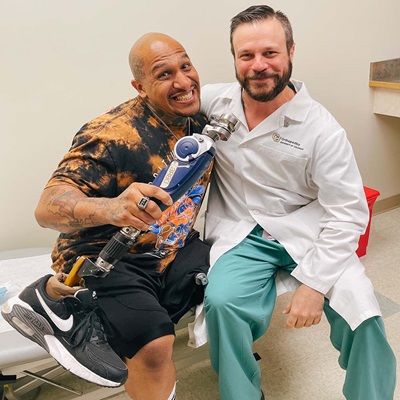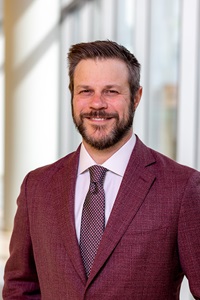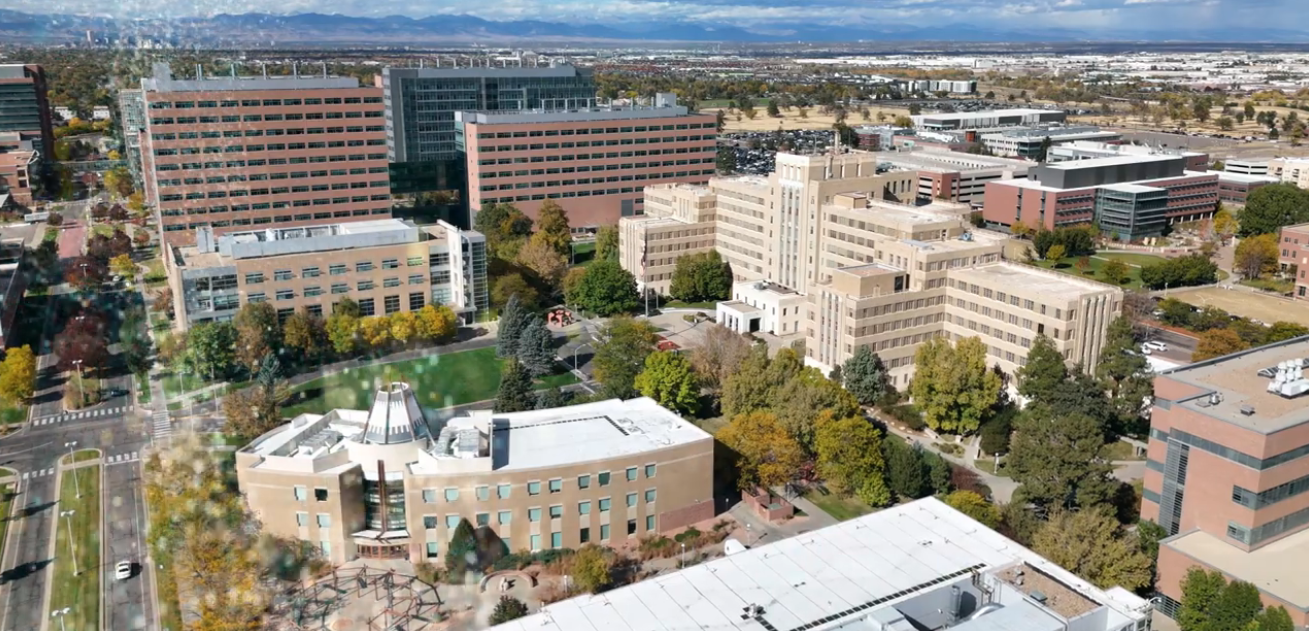CU Limb Restoration Program - Osseointegration
Osseointegration is an advanced reconstructive surgery technique for amputees that eliminates the need for a traditional prosthesis. Because the implant connects directly with the bone of the residual limb, osseointegration patients regain body awareness and improve their balance and gait.
Osseointegration offers patients a better quality of life and improved function & mobility without the usual socket prosthesis-related issues such as pinching, sweating, muscle weakness, and skin irritation.
Osseointegrated bone-anchored prostheses can be implanted in the humerus (upper arm bone), radius or ulna (forearm bones), femur (thigh bone), or tibia (lower leg bone).
What is Osseointegration
Am I a Candidate for Osseointegration Limb Replacement?
Osseointegration implants are a good option for amputees who are having a poor experience with their current prosthesis or do not want to use a traditional prosthetic leg or arm. Socket prostheses can be difficult for patients with a residual limb that is scarred, short, or wide. Because osseointegrated implants are implanted directly into the remaining bone, the shape of the residual limb does not cause the pain and discomfort patients typically feel with a traditional socket prosthesis.
Patient Evaluation Process

Why choose the University of Colorado Limb Restoration Program?
Dr. Jason Stoneback, Director of the Limb Restoration Program, is one of the few physicians across the globe who has been trained in all osseointegration implant procedures.
Since its founding in 2015, the University of Colorado Limb Restoration Program has been unique in its comprehensive, multidisciplinary approach. All of our patients receive world-class care and personalized attention. Each patient is monitored by our Osseointegration Program Coordinator, who guides patients through the program.
Our team includes a social worker and amputee rehabilitation specialist, as well as physicians specializing in wound care, plastic surgery, foot & ankle care, interventional radiology, endocrinology, rehabilitation medicine, prosthetics, infectious disease, gait analysis, vascular medicine, and musculoskeletal oncology. We are proud to earn our 100% patientsatisfaction rate.
Our Team Members
Osseointegration Physicians

Jason W. Stoneback, MD
Dr. Jason W. Stoneback, Director of the Limb Restoration Program, was one of the first orthopedic surgeons to offer osseointegration surgery in the United States and is widely considered to be one of the best osseointegration surgeons in America. He has performed over 100 successful osseointegration surgeries and is regarded as a world expert in the field. Dr. Stoneback has been a practicing orthopedic surgeon since graduating from the University of Tennessee in 2006 and was trained in both OPRA and press fit osseointegration techniques in Germany and the Netherlands. He strongly believes in the connection between form and function and strives to provide patients with real options – often when all other choices have been exhausted.
Learn more about Dr. Stoneback’s clinical and research work by clicking here.

Danielle Melton, MD
Dr. Danielle Melton, Director of Amputation Medicine and Rehabilitation for the Limb Restoration Program, specializes in the rehabilitation of orthopedic trauma patients. She is a leading medical expert on amputation medicine and osseointegrated amputees and has been selected by her peers as a “Best Doctor in America” every year since 2009. She is the Co-Chair of the Limb Restoration Rehabilitation Group of the American Congress of Rehabilitation Medicine, serves as the Scientific Chair for the Limb Loss and Preservation Registry (a National Institutes of Health/Mayo Clinic initiative), and does research with the Department of Defense’s Major Extremity Trauma Research Consortium (METRC).
Learn more about Dr. Melton’s clinical and research work by clicking here.
Osseointegration News & Video
-

At the Forefront” Chancellor Newsletter, “Love, Life and Limbs Restored
Feb 13, 2024For Josh and Melissa Bryan, it was love at first sight. Though these high school sweethearts parted ways when Melissa went to college, they rekindled their relationship five years later at a family wedding.Full story -

Bone-anchored Prosthesis Doesn’t Prevent Limb-loading AsymmetryOpens in a new window
Jun 14, 2024While early evidence suggests improvement in joint and limb loading mechanics during walking with a bone-anchored limb compared to socket prosthesis use, a team of researchers foundOpens in a new window Full story -

Once aiming for the Olympics, skier embraces new life after heart-wrenching accidentOpens in a new window
Jun 24, 2024When David Schlicht completed an aerial ski jump at the Park City Utah Olympic Park three years ago, his aspirations were as high as the air he caught on the cork 720 trick he landed.Opens in a new window Full story -

From the Start: The Roots of O&P Multidisciplinary TeamsOpens in a new window
Jun 24, 2024Pooling specialized knowledge from multiple disciplines and working together to improve outcomes for patients with complex limb loss issues seems like a great idea. As increasing attention is focused on the growth and success of such teams, we asked multidisciplinary team members where the idea started, why it didn’t happen sooner, and where it’s going.Opens in a new window Full story -

This Is Where Dreams LiveOpens in a new window
Feb 4, 2025The University of Colorado Anschutz Medical Campus is a world-class medical destination at the forefront of transformative science, medicine, education and healthcare.Opens in a new window Full story
OUR LOCATIONS
OUR LOCATIONS
PRACTICE LOCATIONS
CU Limb Restoration Program - University of Colorado Hospital
1635 Aurora Court Anschutz Outpatient Pavilion, 4th floor, Aurora, CO 80045To make an appointment call: 1-844-800-LIMB (5462)
Fax: 720-553-0402
For urgent or emergency transfers, call the Access Center at: (720) 848-2828
E-Mail:
[email protected]
